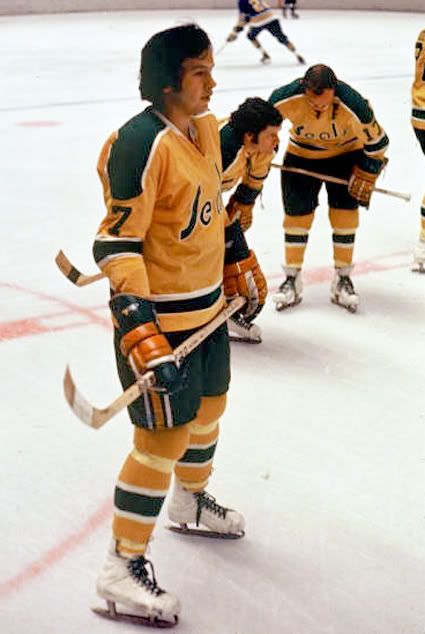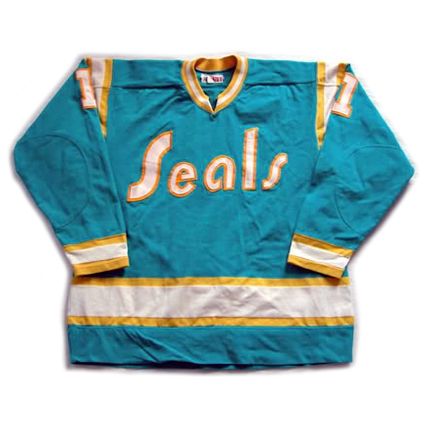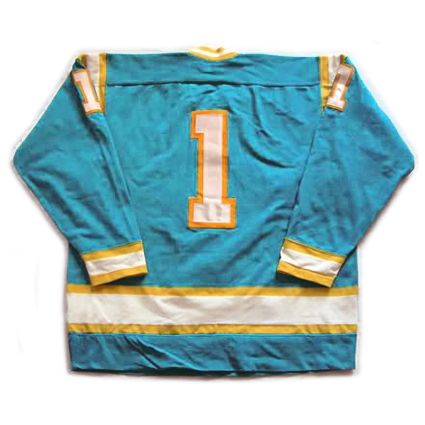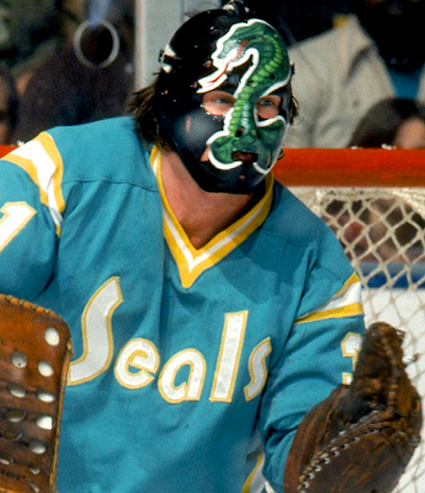Politically, Swig and the Gunds were relying on Swig's political connections with San Francisco Mayor Joseph L. Alioto to get a new hockey arena built downtown. "Alioto was very helpful, " Gund remembered. "He had hoped to put the team where the Moscone Center is now. It was very close to public transportation."Regrettably for the Seals, Swig's timing was off. Alioto was leaving office and Swig supported the wrong man in the 1975 election. When George Moscone took office, the new arena died. "The new mayor put the building on hold." Len Shapiro said. "He ran an investigation into the report and then said the survey had to be resurveyed , so basically, it went nowhere. Then there were plans to remodel the Cow Palace but that never happened either." Once those two plans fell through, the Seals were finished in the Bay Area."After the new arena in San Francisco fell through, the league gave us the go-ahead to move the team." Gund remembered. "We looked at a lot of other places. We looked at Denver and Seattle-Tacoma. We ended up picking Cleveland because hockey was very popular there."Rumors that the Seals would leave the Bay Area were almost as old as the team itself. The owners were quietly but aggressively looking over other locations. The NHL had planned expansion franchises for both Seattle and Denver, which were supposed to begin play in 1976-77. The new entires, though, were experiencing problems so moving the Seals to those cities was still a possibility.Shapiro recalled when he first got an inkling the team might be leaving. "On February 1, 1976, I realized something might be up. I was in the office with Loretta Marcus [the team's secretary] and nobody else was there. I had no idea where anybody was. I looked at Munson Campbell's schedule and it said he was booked at the Cleveland Hilton. Then I knew something must be up."George and Gordon Gund owned the Richfield Coliseum in Richfield, Ohio, where the NBA's Cleveland Cavaliers played. It was halfway between Akron and Cleveland, a location that would cause the franchise more problems in the future. In typical Seals fashion, even it's exit was not smooth. The club participated in the July 1976 entry draft as the Seals and even started selling tickets for the upcoming season in Oakland.At the 1976 entry draft, the Seals made history by becoming the first NHL team to use its frist-round draft pick on a European player by drafting Swedish defenseman Bjorn Johansson. The team didn't make it's intention to move officially known until August 26, 1976. It was announced that the team would move to Cleveland and take the name of the AHL franchise that played there for so many years, the Barons. Because of the late move, the Barons had a mere six weeks to sell tickets in their new home. Once again, the franchise started its new life behind the proverbial eight ball.
Wednesday, August 26, 2009
1974-75 California Golden Seals Marv Edwards Jersey
The ever name changing California Seals were founded as part of the great NHL expansion of 1967-68. The San Francisco area was not considered a particularly lucrative market for hockey, but the terms of a new television agreement with CBS call for two of the six new expansion teams to be located in California, with the other being the Los Angeles Kings.
The team was supposed to have been located in San Francisco, but the arena was never built and instead, the team was based across the bay in Oakland. First called the California Seals to appeal to fans in San Francisco and address complaints from other NHL teams that complained that Oakland was not considered a major league city, as it's only other professional sports team at the time was the Oakland Raiders of the American Football League. On November 6, 1967, owner Barry Van Gerbig announced that the team's name was being changed to the Oakland Seals.
Poor attendance led to Van Gerbig threatening to move the club and a poor record on the ice led to only seven of the original 20 players remaining on the team in it's second season. While they did finish with records below .500, they would make the playoffs for the next two seasons, the only times the club would qualify for the post season in their history.
Van Gerbig sold the team to a group called Trans National Communications in time for the 1969-70 season, but when the group filed for bankruptcy, ownership reverted to Van Gerbig, who put the club up for sale again.
The Oakland Seals were then purchased by Charlie O. Finley, owner of the Oakland Athletics baseball club, who had moved to the bay area in 1968. Never one to sit still, Finley renamed the team the California Golden Seals and altered the team's green and blue colors to green and gold, matching those worn by his baseball club, as well as having the team wear flashy white skates!
Unfortunately the the Golden Seals finished dead last in the NHL during their first season under Finley's ownership with just 45 points from 78 games. Even worse,their first overall pick in the 1971 NHL Entry Draft, along with Francois Lacombe, had already been traded to the Montreal Canadiens for their first round pick in 1970, used by he Golden Seals to take Chris Oddleifson, Ernie Hicke and the always useful cash. The Canadiens used the draft choice obtained from the Golden Seals to select future Hall of Famer Guy Lafleur.
The team improved by 15 points the following season, but suffered from the emergence of the World Hockey Association, as the frugal Finley refused to match the WHA's contract offers to his players resulting in five of the team's top ten scorers leaving and the Golden Seals once again sank to the bottom of the standings with 48 points in 1972-73 and followed that up with just 36 points in 1973-74.
Matters were made worse, if that's possible, by a divisional restructuring which somehow found the Golden Seals placed in the newly created Adams Division with the Boston Bruins, Buffalo Sabres and Toronto Maple Leafs, in an apparent effort by the league to kill off the franchise, as each of the other clubs were a minimum of 2300 miles to the east!
Having grown tired of owning the hockey team, especially in direct comparison to his World Champion baseball team, Finley tried unsuccessfully to sell the Golden Seals, which were eventually eventually taken over by the NHL.
Melvin Swig then purchased the team in 1975 with plans to have the team play in a new arena in San Francisco. Those plans never came to pass following the election of a new mayor opposed to the plan, so after nine money-losing seasons, low attendance and few victories, minority owners George and Gordon Gund convinced Swig to relocate the team to their hometown of Cleveland, Ohio, a move that was announced on this date in 1976, making the club the first NHL team to relocate since 1934 and bringing to and end the Golden Seals ordeal in California, where the team had more names than playoff appearances!
Under the Gunds ownership, the Barons played in Ohio for two seasons, merged with the Minnesota North Stars, who were then sold to another group while the Gunds received an NHL expansion franchise, the San Jose Sharks, at the south end of San Francisco Bay, 40 miles from where it all started.
Today's featured jersey is a 1974-75 California Golden Seals Marv Edwards jersey. After the departure of owner Charlie O. Finley, the Golden Seals colors were changed from his signature green and gold to the even less intimidating "Pacific Blue" (teal) and "California Gold" (yellow), quite probably the worst colors for an NHL team ever, and also giving the team more color schemes in the end than playoff appearances as well.
Another odd characteristic of these jerseys were the decidedly "football jersey" vertical stripes where the arms meet the body of the jersey, something we don't believe has ever appeared on an NHL jersey before.
We actually had not planned on including these jerseys in the "Curious, Weird and Ugly" Collection of the past couple of weeks, originally planning on simply a look at the Seals history on the anniversary of their move to Cleveland, but the more we looked at their final teal and yellow set of jerseys, the worse they looked and the more we knew we had to add one more to the collection. We rate this jersey as "Curious", "Weird" and "Ugly", for a rare trifecta.
Curious are the football stripes on the upper arms, while weird is the choice of pastel colors for a team in a full-contact sport. Honestly, I've seen more intimidating Easter eggs. While the gold and purple of the Los Angeles Kings was unorthodox, it was at least explainable as relating to the colors of royalty and the purple dark enough to offer some contrast to the gold while the choice of teal and yellow leaves me repeating "Only in California" as the whole package of odd striping, inappropriate colors and bland logo can only add up to ugly without a doubt.
Not even the addition of goaltender Gary Simmons' black goalie mask with a frightening green cobra was enough to offset the "only in California" colors of the Golden Seals final jersey set.
Here are some fantastic old videos of the Seals in action. Check out those rinkside seats for $5.50 and playoff tickets for $12. Sign me up!
We don't care how hard you punch, there's just no dignity in wearing those teal jerseys.
That wraps up our trip through the "Curious, Weird and Ugly" Collection. There are other jerseys that certainly qualify, most specifically the Atlanta Thrashers alternates of 2003-04, or the Todd McFarlane designed Edmonton Oilers alternates of 2001-02, the New York Islanders road construction workers vests of 2002-03, the Vancouver Canucks color fading alternates of 2001-02 or the Philadelphia Flyers alternates of 2002-03 as well as nearly anything and everything from the Reebok Edge Uniform System™ (9% less wind drag, 14% lighter and 50% more expensive!). Many also mention the Calgary Flames "Flaming Horse Head" alternates of 1998-99, but we happen to think those are a work of art and refuse to add them to the discussion.
The most recent entry in the collection, confirmed by any search on the internet for "ugly hockey jerseys", is the Montreal Canadiens 1912-13 throwbacks worn last year to celebrate the Canadiens 100th anniversary which were most often compared to prison uniforms. They were scheduled to wear them twice, but then coach Bob Gainey opted to skip their second scheduled appearance due to the reaction to them after the first time and go with the more traditional 1916 jerseys instead.
There could also be a book written about some of the "Hideous, Stupid and Embarrassing" jerseys that have been forced on unsuspecting minor league hockey players over the years, but the vast majority of those are one time only jerseys that are outlandish on purpose in order to generate some publicity for the clubs, unlike the strange and weird NHL jerseys I've chronicled that were meant to be taken seriously only to suffer the unanticipated backlash from both the fans and the media.
If you have any nominees for inclusion in the "Curious, Weird and Ugly" Collection, feel free to add your thoughts in the comments section below.
Subscribe to:
Post Comments (Atom)















Never really liked these Seals jerseys. Absolutely loved the originals they had. Those are one of my all-time favorites.
ReplyDeleteAnd I kind of liked the Flyers alternate you highlighted with your link. I thought they looked pretty good. Given how some of the alternates were bad or worse (Thrashers!).
Dude! How can you call that Checkers jersey (which I own, incidentally) "Hideous" when I had to sit through this monstrosity for two years as a season ticket holder: http://farm2.static.flickr.com/1191/1056582978_55a6dd2162_o.jpg LOL!
ReplyDeleteAlso, which category does the McFarlane Oilers fall into? I always thought they looked pretty sharp, and I H-A-T-E the Oilers. Keep up the good work here.
I think the Thrashers jerseys get a bad rap, they don't have a history to live up to and they took advantage and did something different. In an NHL where numbers are being unnecasarily added to the front of jerseys it took balls to take some off and remind the players who they're playing for.
ReplyDeleteI'd consider the Oliers "robo-drip" alternate to be both "curious" and somewhat "weird". It certainly wasn't the usual, safe "rotate the colors, promote the secondary logo" formula. I can see where McFarlane was going with it, so you have to give him some credit for being adventurous, but it certainly was a bit of an oddity going with the relatively monochromatic colors and Star Trek font for the names and numbers.
ReplyDelete